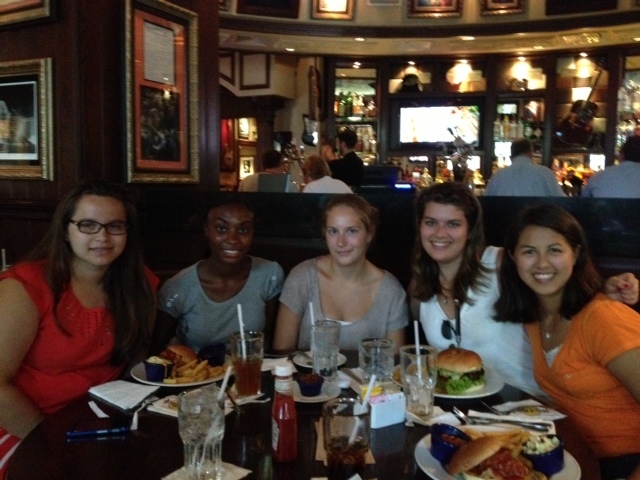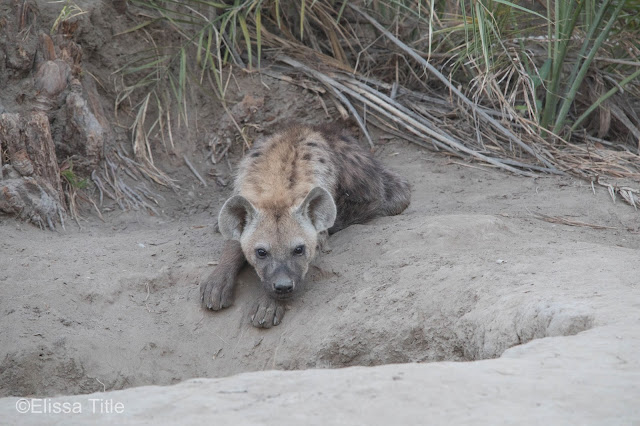A full day's worth of game drives in Tswalu proved rewarding. In the morning, we headed to the wild dog den. There were once half a million wild dogs that roamed Africa, spanning roughly 39 countries but today, only 3,000-5,300 remain in only 13 countries. There were once packs of more than 100 members strong but over time, African wild dog populations in central and northeast Africa were wiped out. Now, these beautiful canines have an endangered status (and are the second most endangered carnivore in Africa after the Ethiopian wolf) thanks to land clearance, urbanization that reduces their hunting grounds, exposure to infectious diseases carried by domestic dogs and human/wildlife conflict (as wild dogs sometimes kill livestock and farmers shoot the dogs in retaliation). These dogs live in packs of up to 28 and here at Tswalu, there are currently 13 little wild dog puppies! While packs are nomadic, covering a home range of more than 80-1,000 square miles, the pack is stationary when they have pups. Because the dogs at Tswalu have pups, they are very stationary... It's just a waiting game.
On our first early morning game drive, we raced over to the wild dog den, the cold, winter Kalahari air nipping at our faces as we sat in the vehicle with our buffs, beanies, scarves, and a blanket with a warmed hot water bottle on our lap. After about 40 minutes, we reached the wild dog den... and there was nothing there. We waited, and waited, and waited for what felt like forever. We saw one older wild dog laying down outside the den and at one point he got up. We chased him around for awhile thinking maybe there had been a kill the day before... No such luck. Eventually, we headed back to the den where, finally, the wild dog puppies started to wake up.
 |
| Wild dog puppies waking up from their den. |
Each pack member (male or female) cares for wild dog pups. These highly social animals are led by an alpha male and alpha female, which are the only two dogs that breed. Below are some of my favorite pics from this sighting.
After all the excitement of watching wild dogs play for nearly 2 hours, we stopped for a quick coffee break on top of a glorious sand dune.
 |
| Snacks were set up on the hood of the car! |
 |
| Coffee in the middle of the Kalahari. |
Following our coffee break, we began hot tailing it to a sighting... only our guide Laura said it was a surprise! The surprise was two male cheetah brothers with a hartebeest kill.
Cheetahs' historic distribution is very wide, but in the 1970's European settlers saw these iconic big cats as something to be eradicated. As a result, populations were reduced and today cheetahs occupy only 10% of their historic range... Less than 7,000 cheetahs remain in the wild. This iconic big cat species has distinctive "tear tracks" running from the inside corner of each eye to the mouth that could possibly serve as an anti-glare mechanism for daytime hunting. They rely on prey like small antelopes and impalas, and cheetahs can reach speeds of up to 75 miles per hour. However, their speed can only be maintained for more than a few hundred meters so many hunts result in failure. Did you know cheetahs are the only cat that can't retract their claws??
The following morning, we went back to the wild dog den since I had never seen wild dogs before. On the way there, our guide came across a wild dog kill, where a jackal was helping itself to leftovers. Wild dogs have one of the highest success rates (as high as 70%) of all carnivores. Their prey includes impala, red lechwe, wildebeest, steenbok and warthog. Because wild dogs are extremely active, they need to average one kill per day to keep their energy levels up. They target their prey in packs, using stamina rather than stealth.
 |
| Jackal with a wild dog's kill. |
Once again, we waited for quite some time for the wild dog pups to emerge from the den. But, waiting is everything. The pups and adults ran around our car playing for nearly 2 hours before settling back down for a nap. Below are some of my favorite photos...
 |
| Puppies playing in the early morning. |
 |
| Older wild dogs playing with the puppies. |
On the way back to the lodge, we spotted a few meerkats. Tswalu has some habituated meerkats (over time, three colonies of meerkats have learned to trust humans and accept them as part of their environment largely due to research being conducted on them). Because the meerkat colonies were never encouraged with food, they now look past people and continue with their day to day activities. Because of this dynamic, we were able to stretch our legs and hop out of the vehicle to watch the meerkats.
 |
| Meerkats on high alert, looking towards the sky at a bird flying overhead. |
Specific to the Kalahari, meerkats are agile hunters that live in communities and depend on one another for survival. They belong to the mongoose family and while mongooses are nocturnal, meerkats hunt during the day. At night, they live in burrows, a complex tunnel system consisting of mounds, access holes, and tunnels that lead to numerous sleeping chambers. There's also always an "emergency exit" in case predators try to come into their burrow. Similar to cheetahs, meerkats have a dark band around their eyes which reduces glare from the sun. As a result, they have the ability to see a predatory bird as they look directly up towards the sun. However, they have problems with depth perception and are not able to focus within 20 feet of themselves. Because of their nearsightedness, they can miss food directly in front of them. Instead, they rely on their sense of smell to find food and their curved front claws act as shovels.

Some other highlights from our stay at Tswalu include seeing two three-month old lion cubs and some white rhino. Enjoy these last few pictures of the Kalahari before we head off to Botswana for the Okavango Delta!
 |
| Three-month old lion cub. |
 |
| White rhino, one of the two species of African rhinos. White rhinos are square-lipped while black rhino are hooked-lipped. |
 |
| Oryx in the mid-morning light. |
 |
| A group of eland. |
Thanks for reading about my African adventures... Stay tuned for what's to come and be sure to hit the subscribe button to be notified of new posts! As always, follow my instagram @elissatitle for more pics.





























Comments
Post a Comment